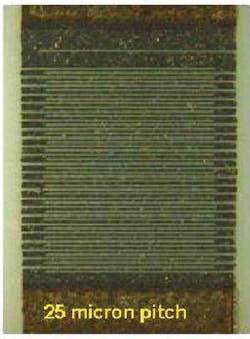Advanced resistor trimming
High precision, small geometry TFCR trimming is possible using green laser systems
Bo Gu, Paul Chase, Gary Mezack, Bruce Couch, Joe Lento, and Yun Chu
Laser trimming has become a successful and indispensable tool for the production of microelectronics devices where high precision and high performance are required. In the case of thin film chip resistors (TFCR) laser trimming is capable of delivering final post processing performance of the TFCR to within +/- 0.02 percent of nominal value. However, the continuing evolution of portable consumer electronics has created the need for even more performance and decreased package size and is further pushing current laser trimming technology.
Manufacturers are now being required to shrink the case size as well as improve the gain adjustment capability, final trimmed accuracy, and repeatability. In order to accomplish these goals simultaneously and in a manner consistent with the high throughput requirements of standard TFCR production lines, a new generation of green (532nm) laser system has been developed. Unlike previous IR laser based systems, the green wavelength affords a significant reduction in the spot size of the laser and a corresponding reduction in the kerf width and thermal effects. Combined with a unique serpentine cutting routine, this provides the basis for a significant increase in the gain adjustments and an increase in final resistor accuracy and repeatability.
null
Thin film technology
Laser trimming of passive or active components on microelectronic circuits has been a matured, field-proven technology for decades. Historically, components with variable values have been used in circuits and most of the operating points of an electronic circuit are adjusted by varying these components’ values. This includes the use of variable resistors, which are very expensive, often unreliable, and difficult to automate and miniaturize. Thin film technology presents a much better alternative and has therefore been widely adopted by the industry. The as-processed tolerance distribution of thin film resistors around their nominal value is typically around 5 to 10 percent. While this is suitable for some applications, it is not appropriate for many portable consumer electronics products. For most applications, tighter tolerances are required. Figure 1 shows the representation of a typical distribution of tolerance values of thin film resistors before and after laser trimming. As shown, laser trimming significantly reduces the spread in the measured value of the thin film resistors with respect to nominal.
The successful use of lasers in trimming thin films is directly dependent on managing and optimizing the laser/material interactions. The conductive films are deposited onto the carrier substrates of glass, ceramic, or silicon using vapor deposition and/or sputtering processes with resulting thickness between 10 µm and 100 µm. Patterns creating the final shape of the passive elements are formed using standard photomask imaging and chemical-etch processing, and thin film resistive values usually range from 100 ohms/square to 1000 ohms/square depending on the materials. The most common thin film materials are nichrome, sichrome, and tantalum nitride. The value of a sheet resistor is equal to the ratio of the length to the width of the sheet multiplied by the sheet resistivity of the material. Therefore, the actual resistance depends on the shape geometry and the property of the film materials.
Laser trimming technology
The laser trimming process changes the value of resistance by simply changing the geometric shape of the resistor film. It does so by removing or changing resistor film material in a specific manner at a specific location. Because the laser trimming can either increase the effective resistor length or shorten the effective resistor width, the value of a resistor can only be increased from the as-processed value.
A schematic of a typical laser trimming system is shown in Figure 2. Three mechanisms can be involved when laser trimming. The first is simply the material evaporation by the high-power laser beam. Examples include tantalum nitride and polysilicon. The second is the oxidization of the resistor material in the presence of silicon dioxide. Such is the case for sichrome and nichrome thin films. The last mechanism is the so-called island structure change in very thin discontinuous films. The conduction is based on quantum electronic tunneling effect.
Traditionally, the wavelength of 1 micron has been used as it is the wavelength from a commonly used industrial laser based on Nd-doped crystals. It also has the proper characteristics for power, repetition rate, beam quality, and material absorption. Recently, as the dimensions shrink and tolerances tighten, it was discovered the traditional 1-micron laser Nd-doped technology experienced trimming limitations on some of the new materials and so an alternative was developed to more successfully manage the laser material interaction issues. Moreover, the trimming quality and post trim stability of the 1-micron wavelength was compromised by thermal and optical proximity effects. It was found that the heat affected zone (HAZ) generated by the laser beam was mostly responsible for post-process resistance drift and TCR.
Shorter wavelengths have the advantages of being able to generate smaller beam and smaller kerf, thus allowing smaller features to be trimmed. Because most materials absorb more strongly at shorter wavelengths than at 1 micron, fewer thermal effects will be expected. Therefore, HAZ at shorter wavelengths tends to be less. This will in turn give rise to less TCR drift, which is caused by the HAZ around the laser trimming kerf.
In addition to laser sources, the beam positioning accuracy is also important in order to achieve high-precision trimming. This is especially true if the dimensions of the components to be trimmed are very small and so a high precision galvanometer beam positioning system was developed to complement the smaller spot size.1 The difference between actual and nominal beam positions are detected and mapped. The entire galvanometer field is mapped in such a manner and fit with mathematical model so the beam placement can be accurately determined.
Application study
Two product test samples were used as the basis for the evaluation, and there were two objectives for each product evaluated. The first was to determine the maximum gain potential for each product under similar conditions (number of cuts, cut length, spacing, etc.). The second was to trim each product to a nominal that reflected a moderate gain, to a tolerance of ±0.1 percent with a standard deviation of less than 0.08 percent. The green W778G Laser Trim System was used for the test with a 3-watt green (532 nanometer) laser with a spot size of 13 microns and kerf widths of 10 microns.
Gain study-To examine the gain potential of each material, a series of serpentine trims using different trim spacing (pitch), was made on a sample quantity of resistors. Trim area was equal-first and last serpentine trim locations, location of the fine trim relative to the serpentine and trim length. The number of trims was changed according to the pitch used so that the last trim location would be as consistent as possible for all samples. Q rate and bite size were kept the same and power adjusted only to maintain a clean and constant kerf. Resistor nominals for each test were selected that would ensure that all resistors trimmed to maximum distance. Six tests were conducted for each material using 25-, 30-, 35-, 40-, 50-, and 65-micron cut spacing. Figure 3 shows the trim pattern for the pitch of 25 microns.
The following data was recorded: pre-trim value, post-trim value, and the time it took to trim the pattern. With that data and the known geometry of the resistor (1.25 squares), the ohms per square, gain, and final square count could be calculated. Tables 1 and 2 show the results for each test group from both resistor materials and the number of cuts used. Table 3 shows the trim parameters used for each test.
With this data it was now possible to develop predictability curves for estimating gain from pitch, pitch from gain, and the number of cuts required for a given pitch. Figures 4, 5, and 6 show the functions obtained from the data.
Figures 4 and 5 show the average gain versus the pitch for 1500 ohm and 40 ohm, respectively. The two materials have very similar trends. Using the function from the trend analysis, a predicted gain is calculated and plotted to show the predicted gain versus actual. The trend functions can be used to estimate the maximum gain for a given pitch. Assuming the two trends are common enough to be averaged, they can be combined to generate a common trend and single function. Figure 6 shows the 1500- and 40-ohm gain curves along with their averaged gain curve and its derived function. A predicted gain is then compared to the combined average.
One can plot the pitch against gain so that the pitch needed can be estimated for a required gain. The required gain being determined by:
Final Resistor Value Required / Average Pre-trim Resistor Value
To now determine if the calculated pitch will leave an acceptable path width, the path width can be estimated by subtracting the approximate kerf width from the calculated pitch:
Path Width = Pitch - Kerf Width
The averaged gain data of both resistor materials can be best fit by the function
y = 756.73x-0.4417
where y is the pitch and x the gain. Therefore, for a given gain, the required pitch can be estimated. Similarly, the maximum number of cuts can be approximated by the function
y = 1058.8x-0.9617
where y is the number of cuts required and x the pitch needed for the given gain.
Trim accuracy study-As mentioned, the goal was to determine the yield possible for a 0.1 percent tolerance resistor with a standard deviation less than 0.08 percent for each resistor material. For the 1500-ohm material a nominal of 1.5 Meg ohms was used, for the 40-ohm material the nominal used was 25 K ohms.
The 1500-ohm material was trimmed first. Two plates were processed using the standard serpentine trim pattern with a deferred fine trim. In this process a row is first trimmed to approximately 99 percent of target and then the row is fine trimmed with a last trim to bring the resistor to final value. The as-trimmed yields were greater than 99 percent for both substrates. After 22 hours the plates were re-measured. The means shifted positive by approximately 0.5 percent. The standard deviations expanded from 0.009 and 0.008 percent to 0.08 and 0.09 percent, respectively-approximately a factor of 10.
For the third substrate, trimming was done in two steps. First the serpentine was trimmed to a target 1.5 percent below the nominal. The substrate was then left for 24 hours at room temperature. The next day the final trim was made. After 22 hours the substrate was re-measured as were substrates 1 and 2. The mean drift was less than 0.04 percent and the standard deviation stayed basically the same at 0.01 percent. The yield remained the same at 99 percent.
For consistency with the 1500-ohm materials’ results, the 40-ohm material was trimmed in the same manner. The first two plates were trimmed with the serpentine and fine trim together. The means shifted less than 0.1 percent and the standard deviation expanded by only 0.01 percent after 22 hours. The yield after 22 hours was >99 percent.
For the split trim process used on the third plate, the mean drift was even less going from -0.0242 percent as-trimmed to -0.0201 percent after 22 hours. The standard deviation was virtually unchanged at 0.0073 percent as-trimmed and 0.0074 percent after 22 hours.
The results of our trim study show that new industry trim requirements are met. The tight distributions and high yields obtained show the capability of the green laser trim system over a wide range of resistor values-from 25 K ohms to 1.5 Meg ohms. Additionally, the trim study examined post-trim drift after 22 hours. After revealing a positive shift in the as-trimmed values of the 1500-ohm material, an alternative trim sequence was demonstrated. This method greatly reduced the drift as the 22-hour post-trim final values indicate. It also demonstrates the flexibility in the system for different trim applications.
For comparison purposes, a 22-hour post-trim testing was done on the 40-ohm material. This post-trim data showed extremely little drift and degradation of the standard deviation-well within the final tolerance. Again, for comparison purposes, post-trim testing was done on the two-part trim process. It produced even less change over 22 hours with virtually zero drift and no measurable change in standard deviation.
Results are in
Advanced trimming systems based on green lasers have been developed. The results show that a green laser with high-precision galvanometers and high-performance machining lens can achieve a smaller kerf width and less HAZ. Tolerance >0.1 percent with standard deviation of <0.08 percent has been achieved. A detailed gain characterization was performed on the test products using a serpentine material removal pattern with various cut spacing. Gains over 2500 times can be accomplished. The green laser technology greatly improved the gain maximum available over that provided by traditional IR laser systems. Additionally, from the baseline measurement data, several predictability functions were formulated to aid in determining if the desired gain was practical based on the path width produced. The study also examined the relationship between pitch and gain with controlled variables. Further, it shows how that data might be used to develop functions for estimating gain, pitch, and the maximum cuts possible for a given set of conditions.
Our results show that thin film resistors trimmed by the green laser can meet the tough tolerance requirement. By reducing the wavelength from 1 micron to 0.5 micron, the spot size can be reduced as well. This spot size reduction becomes more important as the size of resistors continue to shrink. In addition, film materials have much stronger absorptions at green as compared at IR. This absorption results in better cutting quality and less heat affect, thus more stable trim results.
The authors are with GSI Group (Wilmington, MA; www.gsig.com). Contact Bo Gu at [email protected].
Acknowledgements:
The authors would like to thank their colleagues at GSI Group for useful discussions and experimental data.
References
- U.S. Patent 4,918,284.









